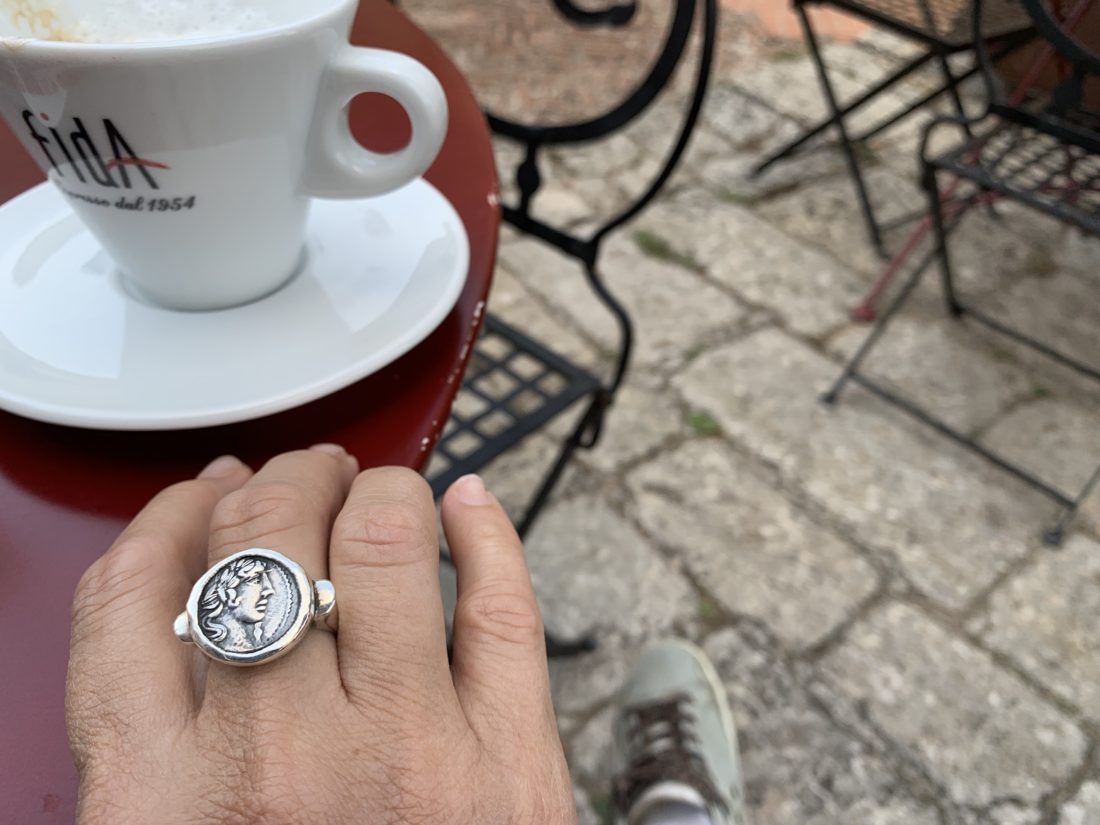
The new man in my life
He may be a bit old for me, but everyone says he has the perfect body. He’s the mysterious, quiet type and never leaves my side. John doesn’t wholeheartedly embrace this new relationship but tries to understand my passion. My new love’s name is Apollo and he comes from around 90 BC.
I’ve been on an eight-year quest to find the perfect ring made with an antique coin. Nearly every window of any jeweler I’ve passed by for years has been scanned for “my ring” and always come up short. This quest hasn’t stopped with me—friends and family have also been on the lookout and will occasionally send a text photo asking “Could this be it?”
John, meanwhile, has been all sang froid and thought he had the perfect hand to play. We live on nine acres of land that is listed as archaeologically significant for possible Etruscan and Roman artifacts. Whenever I whined about wanting this kind of ring he’d tell me to go out in the yard and find the coin myself. Unfortunately all of our restoration, trenching for putting power lines underground, and gardening has turned up nothing more significant than broken bits of recent crockery.
So I meet my lovely niece, Christine Sarkis, in Rome as she started her Italian vacation. She’s a travel editor and had recently done a story about unusual stores in Rome, including a small store noted for its jewelry created from coins, called Serra. Mysteriously we found time in our crowded morning to go to the shop. And I met Apollo.
Alessandro Serra, the third-generation of the family to have the shop, became fascinated by Roman history, and through it, by coins, which helped to make the abstract tangible. The coins find their way into our modern world mainly as a result of having been buried for safety, particularly at the fall of the Roman Empire. When troves of a few hundred coins are found they find their way to experts who verify them, and then sell at auction (with the guarantee of taking them back if found to be inauthentic.) Alessandro started buying at auction and assembled an interesting collection from which he makes jewelry. Part of the reason that Roman coins are relatively plentiful is that the empire was so widespread, and controlled by soldiers, all of whom needed to be paid every month. Silver coinage was a way to do that and made its way to all corners of Europe.
In addition to being built Apollo is also the god of sun, light, music, truth, healing, knowledge, and the arts, all things I like. And archery, which I don’t know much about but am open to. On the back of the coin is Minerva in her chariot pulled by four horses. In Rome she was best known for arts, trade, and strategy.
I find meaning wearing something that was created by another human so long ago. That was carried around in so many pockets and traded for countless glasses of wine, meals, horses, bread, and God knows what else by people who were so different, yet exactly the same, as me. I was hiking recently on an Etruscan trail (next week’s Itch) that was stunning. I realized that it was more beautiful to me because the natural beauty had been shaped by humans living thousands of years ago. (Somehow more compelling than our more recent interventions. I wonder if a Target parking lot will every give a future generation a rush.)
My coin was widely used in 90BC and was similar to a nickle today. It’s called a denarius, from which many of the current words for money, like dinero, comes. It was the backbone of Roman coinage throughout the empire from about 200 BC to the middle of the 3rd century AD.






No Comments